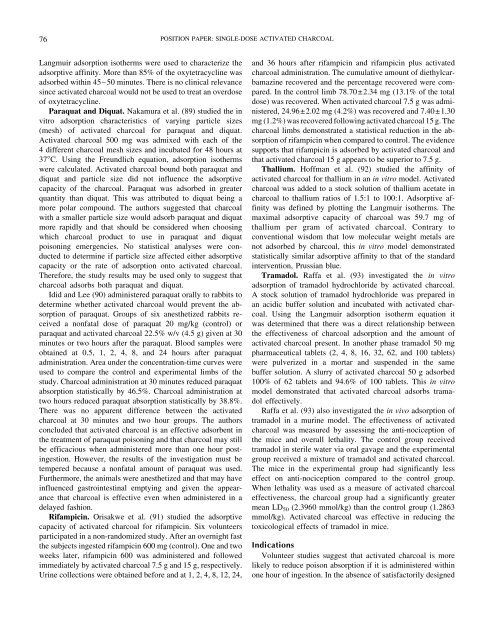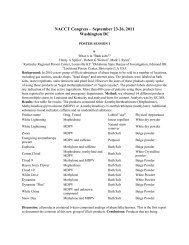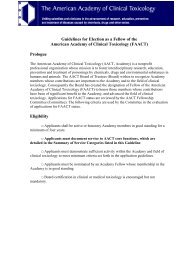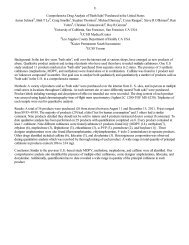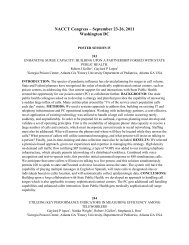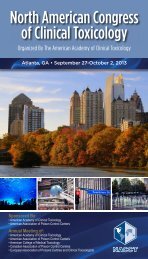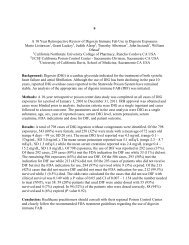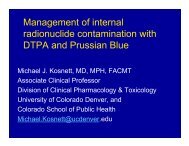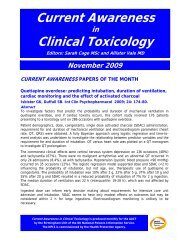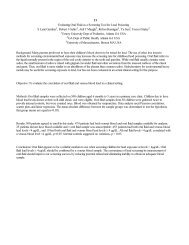Position Paper: Single-Dose Activated Charcoal - eapcct
Position Paper: Single-Dose Activated Charcoal - eapcct
Position Paper: Single-Dose Activated Charcoal - eapcct
You also want an ePaper? Increase the reach of your titles
YUMPU automatically turns print PDFs into web optimized ePapers that Google loves.
76<br />
POSITION PAPER: SINGLE-DOSE ACTIVATED CHARCOAL<br />
Langmuir adsorption isotherms were used to characterize the<br />
adsorptive affinity. More than 85% of the oxytetracycline was<br />
adsorbed within 45–50 minutes. There is no clinical relevance<br />
since activated charcoal would not be used to treat an overdose<br />
of oxytetracycline.<br />
Paraquat and Diquat. Nakamura et al. (89) studied the in<br />
vitro adsorption characteristics of varying particle sizes<br />
(mesh) of activated charcoal for paraquat and diquat.<br />
<strong>Activated</strong> charcoal 500 mg was admixed with each of the<br />
4 different charcoal mesh sizes and incubated for 48 hours at<br />
37°C. Using the Freundlich equation, adsorption isotherms<br />
were calculated. <strong>Activated</strong> charcoal bound both paraquat and<br />
diquat and particle size did not influence the adsorptive<br />
capacity of the charcoal. Paraquat was adsorbed in greater<br />
quantity than diquat. This was attributed to diquat being a<br />
more polar compound. The authors suggested that charcoal<br />
with a smaller particle size would adsorb paraquat and diquat<br />
more rapidly and that should be considered when choosing<br />
which charcoal product to use in paraquat and diquat<br />
poisoning emergencies. No statistical analyses were conducted<br />
to determine if particle size affected either adsorptive<br />
capacity or the rate of adsorption onto activated charcoal.<br />
Therefore, the study results may be used only to suggest that<br />
charcoal adsorbs both paraquat and diquat.<br />
Idid and Lee (90) administered paraquat orally to rabbits to<br />
determine whether activated charcoal would prevent the absorption<br />
of paraquat. Groups of six anesthetized rabbits received<br />
a nonfatal dose of paraquat 20 mg/kg (control) or<br />
paraquat and activated charcoal 22.5% w/v (4.5 g) given at 30<br />
minutes or two hours after the paraquat. Blood samples were<br />
obtained at 0.5, 1, 2, 4, 8, and 24 hours after paraquat<br />
administration. Area under the concentration-time curves were<br />
used to compare the control and experimental limbs of the<br />
study. <strong>Charcoal</strong> administration at 30 minutes reduced paraquat<br />
absorption statistically by 46.5%. <strong>Charcoal</strong> administration at<br />
two hours reduced paraquat absorption statistically by 38.8%.<br />
There was no apparent difference between the activated<br />
charcoal at 30 minutes and two hour groups. The authors<br />
concluded that activated charcoal is an effective adsorbent in<br />
the treatment of paraquat poisoning and that charcoal may still<br />
be efficacious when administered more than one hour postingestion.<br />
However, the results of the investigation must be<br />
tempered because a nonfatal amount of paraquat was used.<br />
Furthermore, the animals were anesthetized and that may have<br />
influenced gastrointestinal emptying and given the appearance<br />
that charcoal is effective even when administered in a<br />
delayed fashion.<br />
Rifampicin. Orisakwe et al. (91) studied the adsorptive<br />
capacity of activated charcoal for rifampicin. Six volunteers<br />
participated in a non-randomized study. After an overnight fast<br />
the subjects ingested rifampicin 600 mg (control). One and two<br />
weeks later, rifampicin 600 was administered and followed<br />
immediately by activated charcoal 7.5 g and 15 g, respectively.<br />
Urine collections were obtained before and at 1, 2, 4, 8, 12, 24,<br />
and 36 hours after rifampicin and rifampicin plus activated<br />
charcoal administration. The cumulative amount of diethylcarbamazine<br />
recovered and the percentage recovered were compared.<br />
In the control limb 78.70±2.34 mg (13.1% of the total<br />
dose) was recovered. When activated charcoal 7.5 g was administered,<br />
24.96±2.02 mg (4.2%) was recovered and 7.40±1.30<br />
mg (1.2%) was recovered following activated charcoal 15 g. The<br />
charcoal limbs demonstrated a statistical reduction in the absorption<br />
of rifampicin when compared to control. The evidence<br />
supports that rifampicin is adsorbed by activated charcoal and<br />
that activated charcoal 15 g appears to be superior to 7.5 g.<br />
Thallium. Hoffman et al. (92) studied the affinity of<br />
activated charcoal for thallium in an in vitro model. <strong>Activated</strong><br />
charcoal was added to a stock solution of thallium acetate in<br />
charcoal to thallium ratios of 1.5:1 to 100:1. Adsorptive affinity<br />
was defined by plotting the Langmuir isotherms. The<br />
maximal adsorptive capacity of charcoal was 59.7 mg of<br />
thallium per gram of activated charcoal. Contrary to<br />
conventional wisdom that low molecular weight metals are<br />
not adsorbed by charcoal, this in vitro model demonstrated<br />
statistically similar adsorptive affinity to that of the standard<br />
intervention, Prussian blue.<br />
Tramadol. Raffa et al. (93) investigated the in vitro<br />
adsorption of tramadol hydrochloride by activated charcoal.<br />
A stock solution of tramadol hydrochloride was prepared in<br />
an acidic buffer solution and incubated with activated charcoal.<br />
Using the Langmuir adsorption isotherm equation it<br />
was determined that there was a direct relationship between<br />
the effectiveness of charcoal adsorption and the amount of<br />
activated charcoal present. In another phase tramadol 50 mg<br />
pharmaceutical tablets (2, 4, 8, 16, 32, 62, and 100 tablets)<br />
were pulverized in a mortar and suspended in the same<br />
buffer solution. A slurry of activated charcoal 50 g adsorbed<br />
100% of 62 tablets and 94.6% of 100 tablets. This in vitro<br />
model demonstrated that activated charcoal adsorbs tramadol<br />
effectively.<br />
Raffa et al. (93) also investigated the in vivo adsorption of<br />
tramadol in a murine model. The effectiveness of activated<br />
charcoal was measured by assessing the anti-nociception of<br />
the mice and overall lethality. The control group received<br />
tramadol in sterile water via oral gavage and the experimental<br />
group received a mixture of tramadol and activated charcoal.<br />
The mice in the experimental group had significantly less<br />
effect on anti-nociception compared to the control group.<br />
When lethality was used as a measure of activated charcoal<br />
effectiveness, the charcoal group had a significantly greater<br />
mean LD 50 (2.3960 mmol/kg) than the control group (1.2863<br />
mmol/kg). <strong>Activated</strong> charcoal was effective in reducing the<br />
toxicological effects of tramadol in mice.<br />
Indications<br />
Volunteer studies suggest that activated charcoal is more<br />
likely to reduce poison absorption if it is administered within<br />
one hour of ingestion. In the absence of satisfactorily designed


